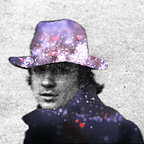Gleitzeit Essays
To Remake the World
After the World’s Remake
Oil Painting by Paul Jaisini
PAUL JAISINI DESTROYES ALL OF HIS PAINTINGS IN 1994 to paint invisible paintings.
To Remake the World
After the World’s Remake
W x H (“) 35 x 35; 35 x35 Signed Oil on Linen
Early Period Before 1994
Among several personages of Dum Spiro Spero there is an executioner.
In the spirit of American “matter of factness” he is decapitating the sphinx.
Another personage is a scientist shown as a moonwalker stepping on a head of a tied up man and the third personage who must signify the incapacitated humanity.
While the blindfolded scientist carries a light lantern the dark powers unfold an apocalypse.
Blindfolding used to be a symbol of moral or spiritual blindness in religious art.
In the painting by Paul Jaisini the light from lantern offers faith symbolic.
The painting’s surface is with the incorporated saying in Latin “While Live Hope” and I like this anchor of life that enters through the veil.
Paul Jaisini concludes one of his paradoxes, uniting two sides of the coin into one, giving another perspective to the theme of creation and destruction.
The artist embodied his work with its saturated hyperreal color of unnatural purple heat.
In the second work of the diptych or a pair to “Dum Spiro Spero” Paul Jaisini shows the notion of what will the world look like after the apocalypse.
The work is titled “After the World’s remake”.
Here the color is wintry cold.
It almost causes to sense the crystallized effect of the world beyond.
The world that is free of heat, free of human warmth and its living energy.
The metaphysical color-heat of the first work impacts the cold color effect of the second painting.
In ancient Egypt Sphinx (The Strangler) was a symbol of power and vigilance represented as lion with human head.
The decapitated sphinx in Dum Spiro Spero could be a significant sign of great cataclysm that is shown in the second work with incorporated aphorism: “When people will understand why the stars are shining sphinx will smile and life on earth would stop.”
Paul Jaisini draws viewer’s attention the paintings’ symbol system and stylistic experimentation, hence the emphasis on the connection of ideas and the artist’s mandatory denotation system of line enclosure.
This continuous line composition builds a self-ruling decorative pattern.
The final composition is almost independent of the picture’s content being decorative.
The manifestation of the connected composition subdues all the elements to one law that is the circuit of interaction of idea with visual representation.
The two paintings are emotionally engaging, eye-catching, and memorable. Perhaps to serve the humanistic idea and assist the artist to create his enclosure that he always needs to accomplish. BY YUSTAS KOTZ GOTTLIEB NYC
gleitzeit.pen.io
